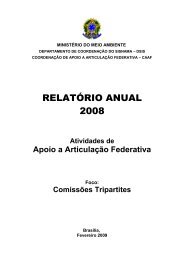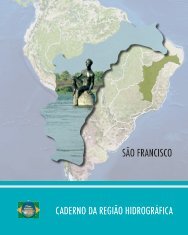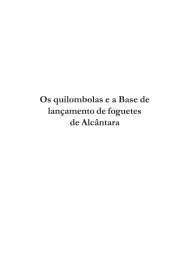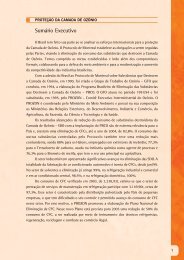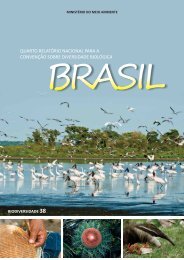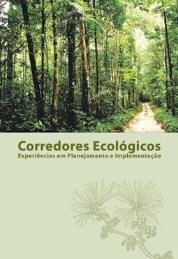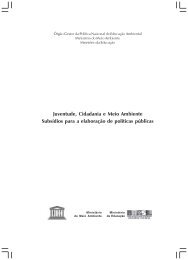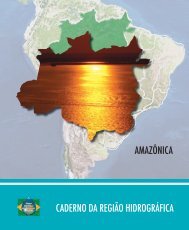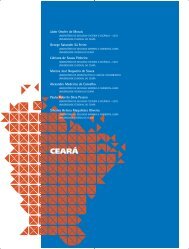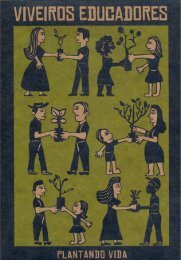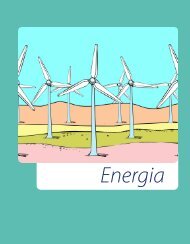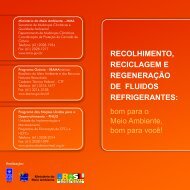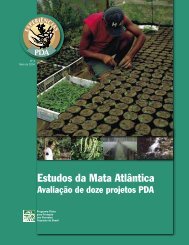Protected Areas
Protected Areas
Protected Areas
- No tags were found...
Create successful ePaper yourself
Turn your PDF publications into a flip-book with our unique Google optimized e-Paper software.
vegetation maps made up between1970 and 1985 by RadamBrasil Projectno longer reflected reality. To fill thisknowledge gap, and to broaden existingknowledge on the Amazon and parts ofthe Atlantic Forest (which are alreadysubject to vegetation monitoring), theMinistry of the Environment (MMA),through the Conservation and SustainableUse of the Brazilian Biological DiversityProject (PROBIO), launched twopublic bids in 2004 for the selectionof subprojects to map the country’svegetation cover according to the biomelimits defined by the Brazilian BiomesMap (IBGE, 2004).The six selected subprojects – one foreach of the Brazilian continental biomes –had the objectives of mapping vegetationcover, diagnosing mapping initiatives, andfilling existing knowledge gaps on thissubject. Vegetation was mapped basedon Landsat images generated primarilyduring 2002, provided to subprojects byMMA. The mapping methodology wasdefined by the executing institutions, andvaried according to the particularities ofeach biome. The technical mapping andlabel standards for all subprojects weredefined with the fundamental technicalsupport provided by the BrazilianInstitute of Geography and Statistics(IBGE). Some of these standards are: 1)minimum mapping unit (UMM) of 40ha,considering a 1:250,000 final scale;2) verifiable digital data compatible,at least, with the 1:100,000 scale;3) classification accuracy (thematicaccuracy) with a minimum threshold of85% correct; 4) output shape-files withtopologic consistency (no overlappingpolygons, no space between polygons, nozero-area polygons, no loops in arches,no polygon without classification, etc.);5) classification of vegetation typesaccording to the IBGE technical manualon vegetation.It is important to note that, accordingto MMA determination, areas withpredominant native vegetation, even ifpresenting a certain degree of humanuse, were accounted for and mapped as anative vegetation type. On the other hand,areas converted to planted pasture, withagricultural crops, reforestations, withmining activities, with urban occupation,and other similar uses in which the nativevegetation is no longer dominant, wereaccounted for and classified as areasunder human influence 9anthropic areas).Another important basic criterion definedby MMA is that secondary vegetationin advanced development stage wasaccounted for and mapped as nativevegetation. The following outputs wereproduced by the mapping subprojects:Final Maps with the cutout and layout ofIBGE 1:250,000 charts of the Brazilianterritory. Format: paper (A0 size);electronic (SHP and PDF files).Database with thematic bases in shapefilescorresponding to the IBGE/DSGcharts at the 1:250,000 scale. Format:electronic (SHP file).Image charts of the chosen biome withthe cutout of IBGE 1:250,000 charts.Format: electronic (GEOTIFF and PDFfiles).Summary (biome mosaic) map. Format:paper (A0 size); electronic (SHP file).Technical Report, according to specificstandard.All of these materials may be consultedand downloaded through the BrazilianBiodiversity Portal – PortalBio/MMA, atthe following address: www.mma.gov.br/portalbio.46



